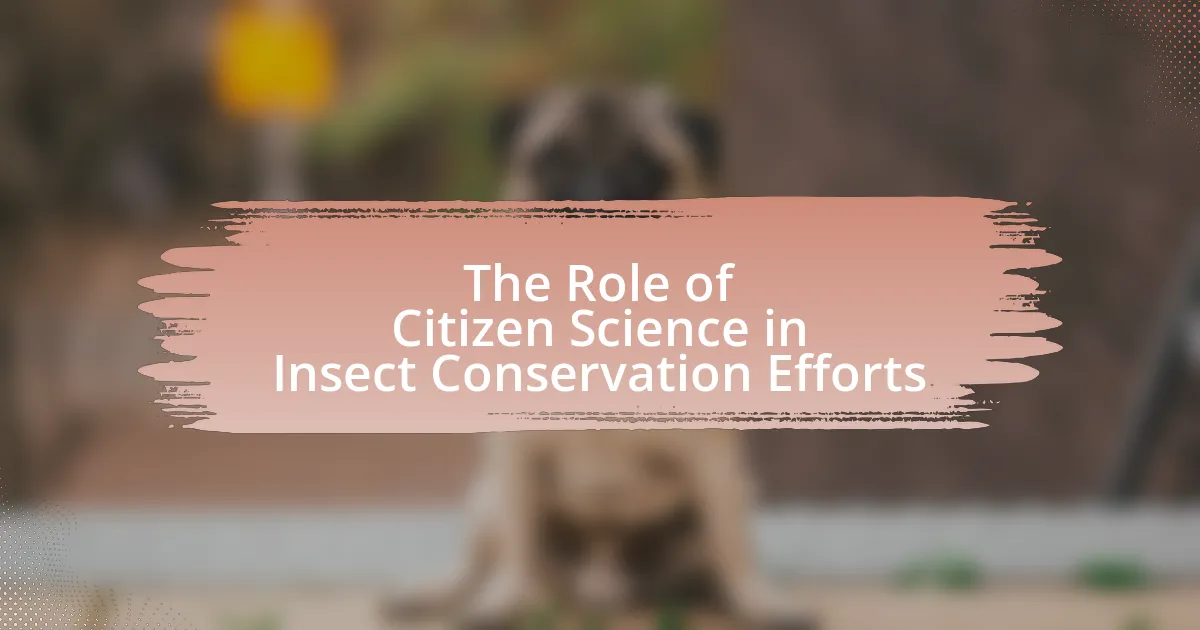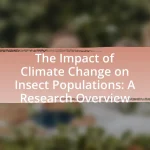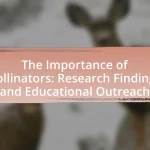Citizen science is a vital component of insect conservation efforts, engaging the public in data collection and monitoring activities that enhance research capabilities. This article explores how citizen scientists contribute to understanding insect populations, their ecological roles, and the challenges they face in data collection. Key activities include species identification, habitat monitoring, and public engagement, all of which support conservation strategies. Successful examples of citizen science initiatives, such as the Monarch Watch program and the UK Butterfly Monitoring Scheme, demonstrate the impact of community involvement on insect populations and public awareness. The article also discusses practical steps individuals can take to participate in these efforts, emphasizing the importance of citizen science in preserving insect biodiversity.

What is the Role of Citizen Science in Insect Conservation Efforts?
Citizen science plays a crucial role in insect conservation efforts by engaging the public in data collection and monitoring activities. This involvement allows researchers to gather large volumes of data across diverse geographical areas, which is essential for tracking insect populations and understanding their ecological roles. For instance, projects like the North American Butterfly Association’s Butterfly Count have mobilized thousands of volunteers, resulting in extensive datasets that inform conservation strategies. Additionally, citizen science initiatives can raise awareness about insect biodiversity and the threats they face, fostering community support for conservation actions.
How does citizen science contribute to insect conservation?
Citizen science significantly contributes to insect conservation by engaging the public in data collection and monitoring efforts. This involvement allows researchers to gather large volumes of data on insect populations, distribution, and behavior, which would be difficult to obtain through traditional scientific methods alone. For instance, projects like the North American Butterfly Association’s Butterfly Count have mobilized thousands of volunteers, resulting in extensive datasets that inform conservation strategies and policy decisions. Such initiatives not only enhance scientific understanding but also raise public awareness about the importance of insect biodiversity and the threats they face, ultimately fostering a culture of conservation.
What are the key activities involved in citizen science for insect conservation?
Key activities involved in citizen science for insect conservation include data collection, species identification, habitat monitoring, and public engagement. Data collection involves volunteers gathering information on insect populations and behaviors, which contributes to larger datasets for research. Species identification requires participants to accurately identify various insect species, often using mobile apps or field guides, enhancing biodiversity records. Habitat monitoring entails assessing environmental conditions and changes that affect insect habitats, providing critical insights into ecosystem health. Public engagement activities, such as workshops and educational programs, raise awareness about insect conservation and encourage community participation, fostering a culture of conservation. These activities collectively support scientific research and inform conservation strategies, demonstrating the significant role of citizen science in protecting insect biodiversity.
How do citizen scientists collect and share data on insects?
Citizen scientists collect and share data on insects through various methods, including field observations, photography, and mobile applications. They often document insect sightings by taking photographs and recording specific details such as location, date, and behavior, which can then be uploaded to online databases or citizen science platforms like iNaturalist or BugGuide. These platforms facilitate data sharing by allowing users to contribute their findings, which are then verified by experts and made accessible for research and conservation efforts. Studies have shown that citizen science initiatives can significantly enhance biodiversity monitoring, with platforms like iNaturalist reporting millions of observations that contribute to scientific knowledge and conservation strategies.
Why is insect conservation important?
Insect conservation is important because insects play crucial roles in ecosystems, including pollination, nutrient cycling, and serving as food for other wildlife. For instance, approximately 75% of flowering plants depend on insect pollinators, which are vital for food production and biodiversity. Additionally, insects contribute to soil health by breaking down organic matter, thus supporting plant growth and agricultural productivity. The decline of insect populations, as reported in studies like the Global Assessment on Biodiversity and Ecosystem Services by the Intergovernmental Science-Policy Platform on Biodiversity and Ecosystem Services, poses significant risks to these essential ecological functions, highlighting the urgent need for conservation efforts.
What are the ecological roles of insects in ecosystems?
Insects play crucial ecological roles in ecosystems, including pollination, decomposition, and serving as a food source for other organisms. Pollinators, such as bees and butterflies, facilitate the reproduction of flowering plants, which is essential for food production and biodiversity. Decomposers, like beetles and ants, break down organic matter, recycling nutrients back into the soil, which supports plant growth. Additionally, insects are a primary food source for many birds, mammals, and amphibians, contributing to the food web’s stability. These roles underscore the importance of insects in maintaining ecosystem health and functionality.
How do declining insect populations affect biodiversity?
Declining insect populations negatively impact biodiversity by disrupting ecosystems and food webs. Insects serve as pollinators, decomposers, and a food source for many species; their decline leads to reduced plant reproduction, increased organic matter accumulation, and diminished food availability for birds and other animals. For instance, a study published in the journal “Biological Conservation” found that a 75% decline in insect biomass over 27 years in Germany correlated with significant reductions in bird populations, highlighting the interconnectedness of species within ecosystems.
What challenges do citizen scientists face in insect conservation?
Citizen scientists face several challenges in insect conservation, including limited access to resources, lack of training, and difficulties in data validation. Limited access to resources can hinder their ability to conduct thorough research or collect specimens, as many citizen scientists operate without institutional support. Additionally, a lack of training can lead to misidentification of species or improper data collection methods, which compromises the quality of the data gathered. Furthermore, difficulties in data validation arise because citizen-generated data often requires expert review to ensure accuracy, which can be time-consuming and may not always be feasible. These challenges collectively impact the effectiveness of citizen science initiatives in contributing to insect conservation efforts.
What are the common obstacles in data collection and reporting?
Common obstacles in data collection and reporting include lack of standardization, limited participant training, and data quality issues. Lack of standardization can lead to inconsistencies in how data is collected, making it difficult to compare results across different studies. Limited participant training often results in inaccurate data entry or misidentification of species, which undermines the reliability of the findings. Data quality issues, such as incomplete datasets or biases in reporting, further complicate the analysis and interpretation of results. These challenges can significantly hinder the effectiveness of citizen science initiatives in insect conservation efforts.
How can citizen scientists overcome these challenges?
Citizen scientists can overcome challenges in insect conservation by utilizing structured training programs and collaborative platforms. Structured training equips citizen scientists with essential skills and knowledge, enhancing their ability to collect accurate data. Collaborative platforms, such as online databases and community forums, facilitate information sharing and support among participants, which can lead to improved methodologies and increased engagement. Research indicates that well-organized citizen science initiatives, like the UK’s Butterfly Conservation project, have successfully mobilized volunteers to gather significant data, demonstrating the effectiveness of these strategies in addressing challenges faced in conservation efforts.
How can citizen science initiatives be improved for better insect conservation?
Citizen science initiatives can be improved for better insect conservation by enhancing data collection methods and increasing participant engagement. Implementing standardized protocols for data submission ensures consistency and reliability in the information gathered, which is crucial for effective conservation strategies. Additionally, providing training and resources for volunteers can empower them to contribute more effectively, as evidenced by studies showing that well-informed participants produce higher quality data. Engaging local communities through educational outreach fosters a sense of ownership and responsibility towards insect conservation, leading to sustained involvement. Research indicates that initiatives that incorporate feedback mechanisms, where participants can see the impact of their contributions, significantly boost motivation and retention rates among volunteers.
What strategies can enhance community engagement in citizen science?
Strategies that can enhance community engagement in citizen science include fostering collaboration, providing accessible training, and utilizing technology for data collection. Collaboration between local organizations and scientists can create a sense of ownership and relevance among community members, as seen in projects like the Great Sunflower Project, which successfully engaged volunteers in pollinator monitoring. Accessible training ensures that participants feel confident in their contributions; for instance, the Citizen Science Association emphasizes the importance of workshops and online resources to equip volunteers with necessary skills. Additionally, leveraging technology, such as mobile apps for data submission, can streamline participation and increase engagement, as demonstrated by platforms like iNaturalist, which has facilitated over 20 million observations by users worldwide.
How can technology be leveraged to support citizen science efforts?
Technology can be leveraged to support citizen science efforts by providing tools for data collection, analysis, and communication among participants. Mobile applications enable users to easily record observations of insect species, contributing to large databases that researchers can analyze for trends and patterns. For instance, platforms like iNaturalist allow citizen scientists to upload photos and receive identification assistance, enhancing the accuracy of data collected. Additionally, geographic information systems (GIS) can visualize data spatially, helping to identify hotspots for insect diversity and conservation needs. The integration of social media facilitates community engagement and knowledge sharing, further amplifying the impact of citizen science initiatives.
What are some successful examples of citizen science in insect conservation?
Successful examples of citizen science in insect conservation include the Monarch Watch program and the Bumblebee Conservation Trust. Monarch Watch engages volunteers in tagging and tracking monarch butterflies, contributing to data on migration patterns and population health, which has been crucial for conservation efforts. The Bumblebee Conservation Trust mobilizes citizen scientists to monitor bumblebee populations through surveys, providing essential data that informs conservation strategies and habitat restoration. Both initiatives demonstrate the effectiveness of community involvement in gathering critical data for insect conservation.
What projects have shown significant impact on insect populations?
Projects such as the UK Butterfly Monitoring Scheme and the Great Sunflower Project have shown significant impact on insect populations. The UK Butterfly Monitoring Scheme, initiated in 1976, has provided critical data on butterfly populations, revealing declines in species and prompting conservation actions. The Great Sunflower Project, launched in 2008, engages citizens in monitoring pollinator populations, leading to increased awareness and habitat restoration efforts. Both projects demonstrate how citizen science can effectively contribute to understanding and conserving insect populations.
How have these projects influenced public awareness and policy?
Citizen science projects in insect conservation have significantly increased public awareness and influenced policy by engaging communities in data collection and education. These initiatives have raised awareness about the decline of insect populations, highlighting their ecological importance, which has led to greater public concern and advocacy for conservation measures. For instance, projects like the Great Sunflower Project have mobilized thousands of volunteers to monitor pollinator populations, resulting in increased visibility of pollinator issues in media and public discourse. This heightened awareness has prompted policymakers to consider regulations aimed at protecting habitats and reducing pesticide use, as evidenced by the introduction of pollinator protection plans in various states.
What practical steps can individuals take to participate in insect conservation through citizen science?
Individuals can participate in insect conservation through citizen science by engaging in activities such as monitoring local insect populations, reporting sightings to databases, and participating in organized surveys. For instance, platforms like iNaturalist and BugGuide allow users to document and share their observations, contributing valuable data to researchers. Additionally, individuals can join local conservation groups that focus on insect habitats, participate in workshops to learn about insect identification, and advocate for policies that protect insect biodiversity. These actions collectively enhance scientific understanding and support conservation efforts, as citizen-collected data has been shown to significantly contribute to ecological research and biodiversity assessments.


